Looking for a new air conditioner (AC) for your home, office, or garage is a daunting task.
There always seems to be some new jargon or AC type on the market you’ve never heard of.
We explain what a ductless AC is, how it works, and some of the technical terms you’re likely to hear during your search.
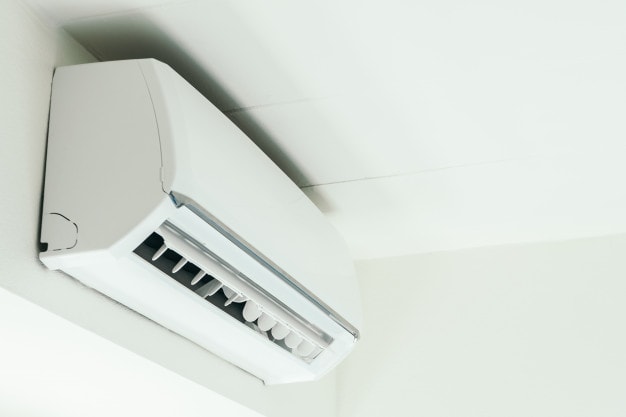
Ductless Air Conditioner Terminology and Common Concepts
A ductless AC is an excellent choice under the right circumstances. They’re more efficient than other comparable systems, and they give you the flexibility you wouldn’t otherwise have. Before continuing, we’ll describe a few of the terms you’ll come across regarding ductless ACs.
What Does Ductless Air Conditioner Mean?
A ductless AC is an HVAC system that doesn’t use ducting to carry the treated air into the room. Depending on the model you choose, it can cool the air or heat and cool using a heat pump method. Some cool the air like a regular AC and have electrical heater elements to heat the air.
Parts of a Ductless AC
A ductless AC has a few different parts, and you need to have an overview of them to understand how this system works.
- Condenser Unit: The condenser unit is sometimes referred to as the outside unit. The outside portion of the AC holds the condenser coils, compressor, and a fan to blow air over the condenser.
- Air Handler: The inside unit holds the evaporator, fine air filter, and blower to push air into the room. It’s also called the air treatment unit, evaporator unit, or the inside unit. It may also contain electrical heating elements.
- Conduit: The conduit carries the electrical cabling and refrigerant piping between the two portions of the AC.
- Remote Control: Most ductless ACs come with remote control for you to directly control the temperature settings, mode, and fan speed in the room.
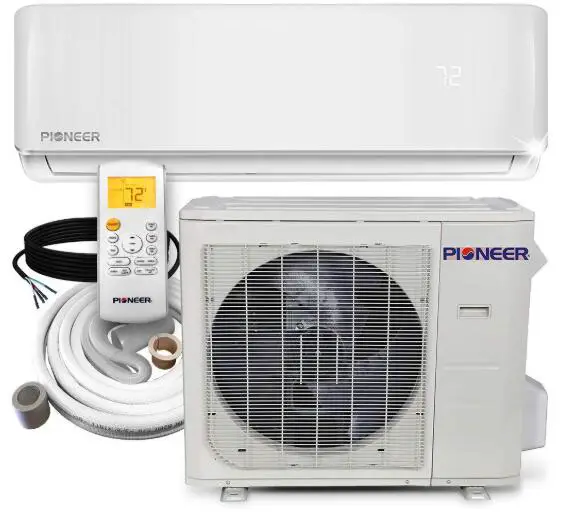
Terms Relating to a Ductless AC
You will find several terms used only for referring to ductless AC systems. These refer to the configuration and mounting options for this type of AC.
- Mini-Split: A mini-split is a smaller ductless AC designed to cool one room only, like a garage or a house extension. There’s one condenser serving one air handler.
- Multi-Split: A larger unit with a condenser and compressor serving multiple air handlers in different rooms.
- Flush-Mount: A recessed design so that the mounting is flush with the wall or ceiling and is more aesthetically pleasing.
- Ceiling-Mount: The air handler is designed to be mounted in the ceiling.
- Wall-Mount: A wall-mounted air handler is designed to be mounted on the room’s wall.
General HVAC Terms Related to Ductless AC
We have listed some general HVAC terms that you’ll also hear related to ductless ACs.
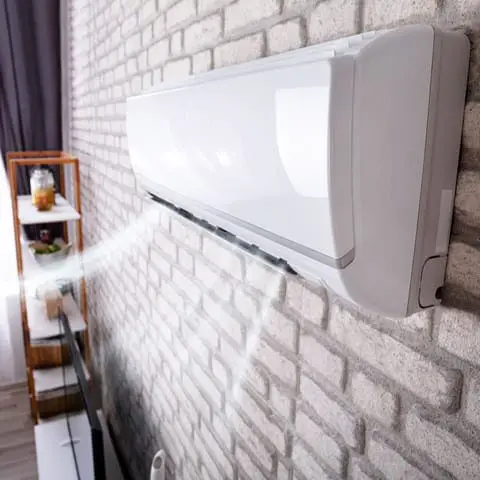
- BTU: BTU stands for British Thermal Units and is used to measure an HVAC system’s cooling or heating power.
- SEER: Seasonal Energy Efficiency Ratio is the cooling output of an AC over a cooling season divided by the energy consumption. SEER denotes the energy efficiency of an AC. A higher SEER means a more energy-efficient AC.
- Heat pump: A heat pump is an AC system that can heat or cool. Canadians sometimes refer to a regular AC compressor as a heat pump.
- Zones: The term zones refer to the air treatment zones in an HVAC system.
- Refrigerant: Sometimes referred to as gas, the refrigerant is the medium that AC systems use to transfer heat.
How Does a Ductless Air Conditioner Work?
A ductless AC makes use of the same AC cycle as any other type, with the main difference being that you don’t need air ducts. The refrigerant travels in a closed loop between the air handler and the condenser, transferring heat from the room to the outdoors. The air is treated at the end-point.
The AC Cycle
Below is an explanation of how the cycle works by component. Because the air treatment is done in the room to be cooled, the ductless AC eliminates the air ducts’ need. Up to 30% of the cooling can be lost through leaky or poorly insulated ducts, making a ductless AC more efficient.
Outside Installation
The outdoor part of the ductless AC houses the compressor, the condenser, and a fan with a filter.
- Compressor: The compressor compresses the refrigerant gas and moves it through the system.
- Condenser and Fan: The next component in the cycle is the condenser and fan. The fan blows cool air over the condenser, removing excess heat from the refrigerant and condensing it into a liquid. The liquid refrigerant continues through the lines to the air handler.
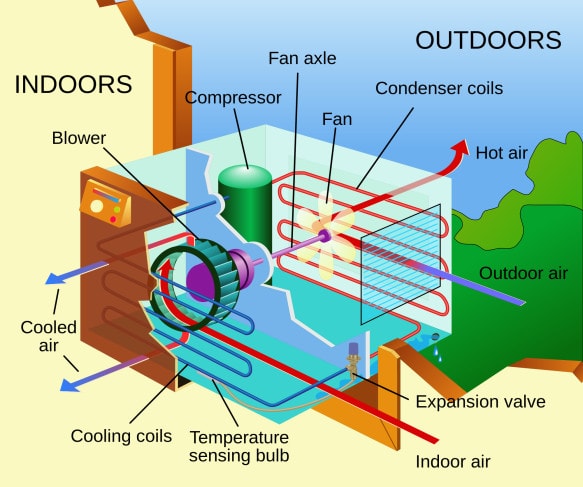
Air Handler
The air handler contains an expansion device, an evaporator, and a blower fan with a fine filter.
- Expansion Device: The expansion device widens the refrigerant line. As the refrigerant expands, the pressure drops, and it begins to boil.
- Evaporator Coil: As the refrigerant enters the evaporator coil, it continues to boil.
- Blower: The boiling process is further aided by the blower, which blows warm air over the coil. The air’s heat is transferred to the refrigerant as it boils, cooling the air from the blower that is blown into the room, cooling it. The refrigerant is returned to the compressor through the lines, and the cycle repeats.
Alternatives to a Ductless Air Conditioner
There are alternatives to a ductless AC. Some of these alternatives are more practical, depending on your application.
We have listed a few of these below with brief descriptions. Also, we list some pros and cons compared to a ductless option.
Ductless AC vs Central AC
A central AC contains one air handler that services all the rooms in a building. Central ACs come in two different variations: a packaged AC and a split AC.
Packaged Central AC
A packaged AC contains all the components in one casing, generally mounted on a concrete slab or a roof. The treated air is ducted into the building from this unit and distributed to the different rooms.
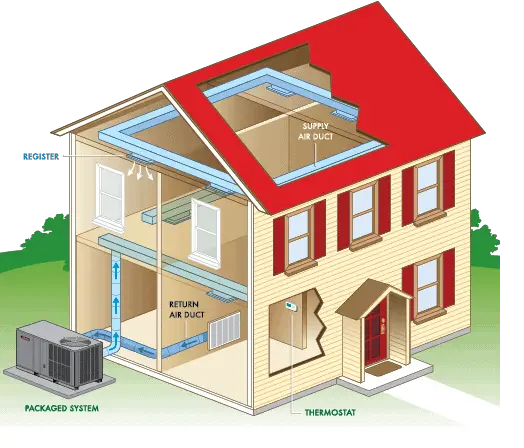
|
Pros |
Cons |
|---|---|
|
Only one air handler to service all the rooms in the building |
Roof-mounted ACs can be challenging to access |
|
All the components are located outdoors, making the AC quieter |
Extra ducts, making the potential for losses higher |
|
With all the components in a single housing, maintenance is more manageable |
Dirt and debris accumulate around the housing, which can impact air quality |
|
The outdoor installation needs some space, and roof-mounted ACs detract from the look of a building |
Split Central AC
A split AC consists of outdoor and indoor components. There’s still a central air handler, but it’s located in an attic or closet. The compressor and condenser comprise the outdoor portion of the installation.

|
Pros |
Cons |
|---|---|
|
Better air quality than a packaged system |
The split AC utilizes indoor and outdoor space |
|
Only one air handler to service all the rooms in the building |
The air handler can be challenging to access, depending on the available space |
|
The AC is still quiet, with the noisiest components located outdoors |
There’s more significant potential for losses of cold air through leaking or poorly insulated ducts |
Ductless vs Window Air Conditioner
A window AC is a smaller, window-mounted unit. The window AC also doesn’t use ducts, but it has all of its components in a single housing.
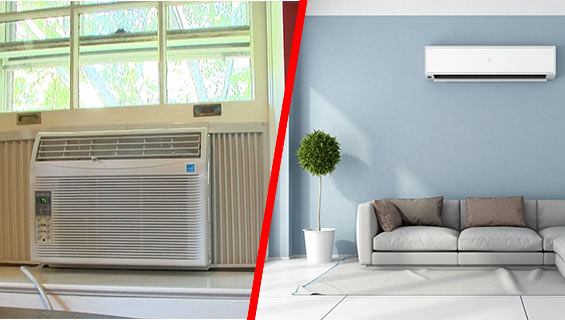
Pros and Cons of a Window AC
Pros | Cons |
|---|---|
|
No air ducts to install and maintain | The unit can look unsightly |
|
Window ACs are cheaper than ductless ACs |
It’s noisier than other AC types |
|
The unit can be removed and stored during winter |
Sealing the window AC isn’t easy |
|
The window AC can be installed by the homeowner |
You sacrifice a window to mount it |
|
All the components are in one housing, making maintenance easier |
Mounting a window AC can be problematic |
|
There’s potential to damage the window sill or frame |
Conclusion
A ductless AC system is a very flexible alternative to other types of ACs. You can use a mini-split system to cool one room of the house or a larger multi-split one to cool all the rooms.
With a multi-split AC, you can directly control the zone’s temperature that the air handler is in. Eliminating the need for ducts makes this a much more efficient system than other types. If you don’t like the idea of having the air handler in plain sight, you can opt for a flush-mounted option.
People Also Ask
Below are answers to a few of the more commonly asked questions regarding ductless ACs.
Up to 30% of the cold air is lost through leaking and poorly insulated ducts. The ductless system is automatically more efficient because there’s no need to make up for these losses. The air’s being treated and cooled in the room.
Ductless ACs circulate indoor air only, so they don’t require venting like a furnace that burns fossil fuels.
A mini-split system targets only one room. However, a multi-split can cool several rooms with one outdoor unit and a separate air handler for each room.
Ductless ACs work very well. A glance at the SEER ratings of ductless ACs tells you how efficient they are. Better efficiency means lower maintenance and a longer lifespan.
Some ductless ACs have an electrical heating element to provide heating. Others use a heat pump system so that the AC can also have a heating mode. How and if your ductless AC provides heating depends on the model you buy, but the options are available.
